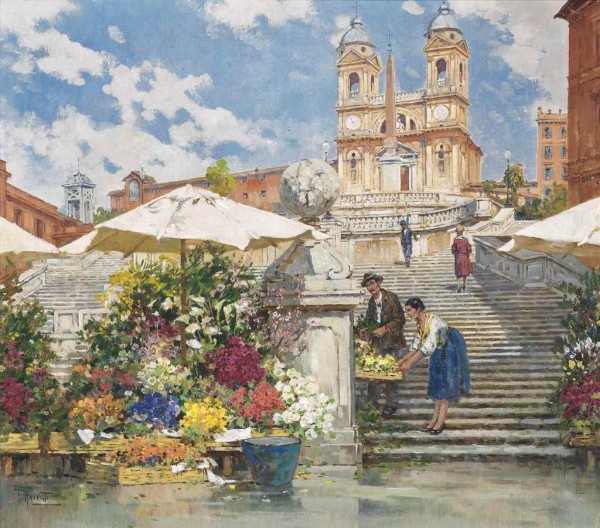
Oh the streets of Rome are filled with rubble
Ancient footprints are everywhere
You can almost think you’re seeing double
On a cold, dark night on the Spanish Stairs
Bob Dylan, ‘When I paint my Masterpiece’, 1971
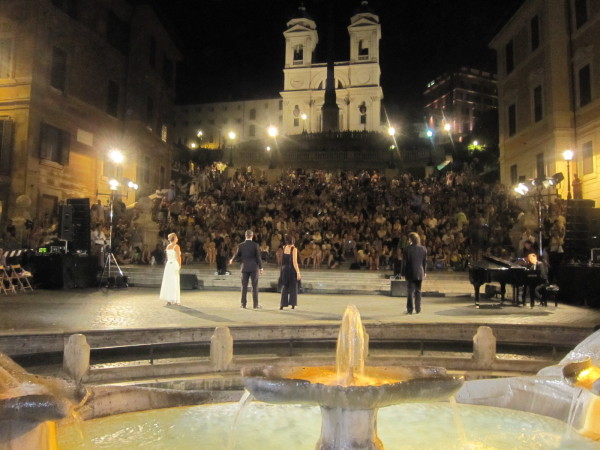
The Spanish Steps have become one of the most famous landmarks of Rome. Each Spring they are decorated with thousands of planter pots filled with colorful azaleas for the Azalea exhibition for the Spring festival. Between August and November, they become the grandstand for free Opera performances. The steps are a meeting point for travelers, a popular photo opportunity and a great place to sit and watch the “show” unfolding in the Piazza di Spagna.
What is unusual about the grand staircase is that there is absolutely nothing Spanish about it.
To fully understand the Spanish Steps and the Piazza di Spagna, you really need to go back to the year 1501.
France had just defeated Spain for the sovereignty of Naples during the 65 year long battle known as the Italian Wars. The war included a cast of international celebrities including Ferdinand and Isabella of Spain, King Louis XII of France, Ludovico Sforza of Milan and Pope Alexander VI and the Borgia family of Rome.
France and Spain had been fighting over Naples since the beginning of the 14th century. Two Hundred years later, they were still at it. These two countries remained enemies until Napoleon redesigned the nations of Europe in the late 18th century. In many way, calling this grand square the Piazza di Spagna is a spit in the face of France.
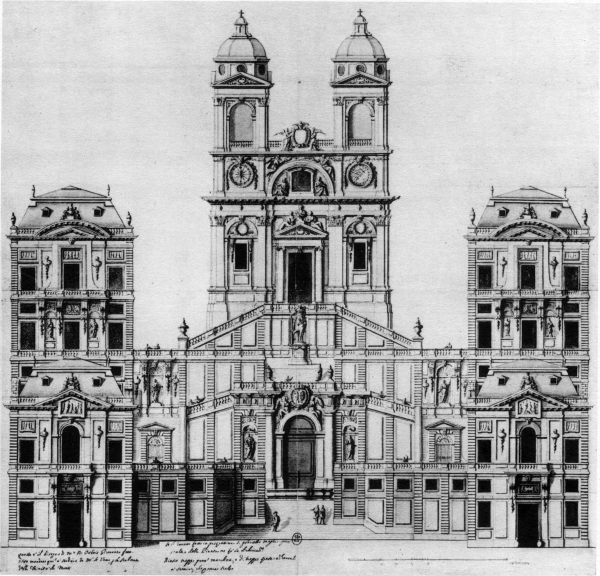
In honor of the 1501 victory, King Louis XII of France commissioned the Trinità dei Monti church to be built on the Pincian Hill overlooking what would eventually become the Piazza di Spagna. Plans were drawn, architects were chosen and then, in 1502, Naples fell back into Spanish hands. All work on the church came to an abrupt halt.
Between the cost of the Italian Wars that didn’t end until 1559 and the Sack of Rome in 1527 by the French, it took 84 more years before the twin bell towered Trinità dei Monti was finally consecrated in 1585.
These days, Trinità dei Monti is the crowning cap on the long flowing staircase that has since become known as the Spanish Steps, la Scalinata di Spagna.
The Platea Trinitaris
With the Church now in place, a larger community began to settle on the plateau below, an area known as the Platea Trinitatis.
Due to it’s proximity to the Porta Flaminia in Piazza Del Popolo, the Platea filled up with Inns, Taverns and tourists from Northern Europe. The Porta Flaminia was the gate used by the many travelers taking advantage of Rome’s tax-free status to tourists and visitors.
![Trinità dei Monti prima della scalinata (picc.verde G.Maggi 1600 ca)_thumb[3]](https://romeonrome.com/files/2016/02/Trinità-dei-Monti-prima-della-scalinata-picc.verde-G.Maggi-1600-ca_thumb3.jpg) At night the Platea was a rough and tumble neighborhood filled with prostitutes and frequented by drunken artists and ruffians. It was here where Michelangelo Merisi (Caravaggio), Orazio Gentileschi and the hot tempered architect, Onorio Longhi would roam the streets looking for strong drink, loose women and a good brawl. More often than not, they found one.
At night the Platea was a rough and tumble neighborhood filled with prostitutes and frequented by drunken artists and ruffians. It was here where Michelangelo Merisi (Caravaggio), Orazio Gentileschi and the hot tempered architect, Onorio Longhi would roam the streets looking for strong drink, loose women and a good brawl. More often than not, they found one.
In 1592, the very wealthy Gianfranco Monaldeschi was convicted of treason against Pope Clement VIII (Aldobrandini).
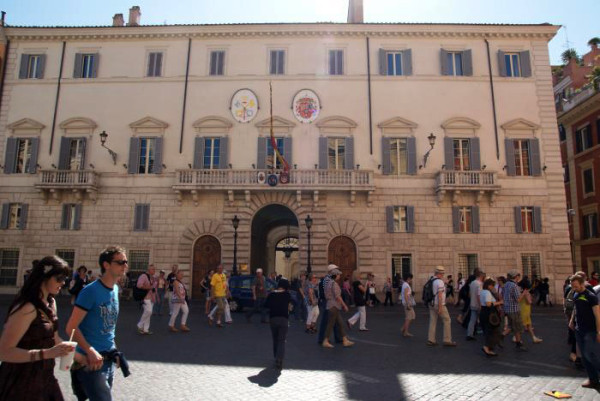
Monaldeschi lands and palaces were confiscated by the Vatican. In 1642, the Monaldeschi Palace on the on the Platea Trinitatis was auctioned off and purchased by Inigo Vélez de Guevara, the 8th Count of Oñate and Spanish Ambassador to Rome. Oñate jumped on the deal to keep it from the French who had occupied most of the area around the Church of Trinità dei Monti.
Oñate made the purchase without even getting approval from the Spanish King Philip III. Although it was a clever property grab, it pissed off the King. In his show of displeasure, he made Oñate wait 10 years for repayment. After finally getting reimbursed 1652, Oñate hired the services of Francesco Borromini and a few other Roman architects to transform the old Monaldeschi Palace into the new Spanish Embassy. The building was completed in 1653. It’s been the Spanish Embassy ever since.
And so, during a time of conflict between French and Spain, two communities of French and Spanish settled side by side on the Platea Trinitatis.
The southern part of the square, near the Piazza Mignanelli was known as the Piazza di Spagna.
The northern part of the square, moving towards the Piazza del Popolo was known as the Piazza di Francia.
Piazza di Francia was connected to the Trinità dei Monti, by a steep ramp, basically a dirt path carved into the hillside, a hillside that would eventually become the famous Spanish Steps.
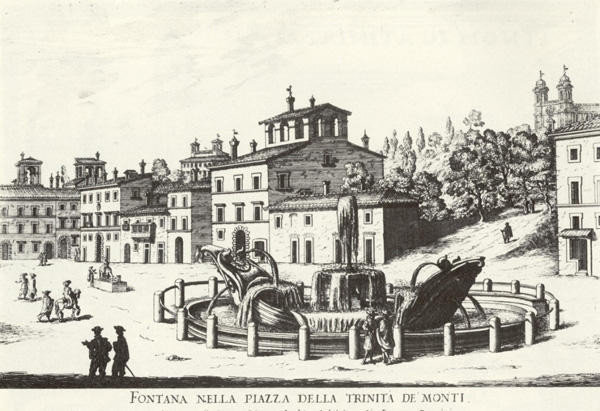 La Fontana della Barcaccia (The fountain of the sunken boat)
La Fontana della Barcaccia (The fountain of the sunken boat)
The Baroque period of the 16th and 17th centuries was one of the greatest building periods of Rome and Pope Urban VIII (Maffeo Barberini) was the Baroque period’s greatest builder. It helped that he had architects like Gianlorenzo Bernini, Francesco Borromini and Pietro da Cortona.
The city hadn’t seen this much construction since the 3rd century of the Ancient Roman Empire.
Ancient Roman buildings were destroyed and recycled into new Baroque churches, Palaces and Grand Piazze. Urban VIII destroyed so much of ancient Rome, it prompted one of the most famous of the 17th century satirical notices to be posted on ‘Pasquino’, one Rome’s talking statues. It read, “Quod non fecerunt barbari fecerunt Barberini” (What the barbarians didn’t do, the Barberini did).
As new neighborhoods were constructed or restored, new populations increased and with more people came the need for more infrastructure, mostly water.
When the 1st century BC Aqua Virgo (now known as the Aqua Vergine) was repaired in 1453, it brought water into the Campo Marzio, terminating in a water fountain in the Piazza di Trevi. In 1572, Giacomo Della Porta built a fountain in the Piazza del Popolo and the Aqua Vergine branched out to another destination. In 1627, Pope Urban VIII decided to tap the Aqua Vergine again and branch the water supply to the new community of the Platea Trinitatis.
He awarded the project to his favorite architect/sculptor, Gianlorenzo Bernini and his father, Pietro Bernini. Although many historians will credit the fountain to Pietro, his son, Gianlorenzo was already a very famous celebrity in Rome when the fountain was started in 1627. Urban VIII awarded Pietro Bernini the project of branching the Aqua Vergine to the Piazza di Spagna but most likely he wanted the younger Bernini’s imagination in designing the fountain.
The Fontana della Barcaccia is a very interesting and often overlooked fountain in Rome. It is a tribute to the legend that when the Tiber river flooded in 1598, the water carried a small fishing boat to the location in the center of the Platea Trinitatis. Bernini was born in 1598. The story seemed to have an importance in his life.
Sinking the boat below ground level was sheer genius. Not only did it accentuate the story of a shipwrecked boat, it also solved the problem of bad water pressure.
When the 19th century poet John Keats was dying in a house across the square from the Barcaccia, he said he could hear the fountain from his deathbed. It made him recall a line from the 1608 Jacobean play “Philaster, or Love Lies a-Bleeding”, by Francis Beaumont and John Fletcher. “As you are living, all your better deeds shall be in water writ”. The line prompted Keats to instruct his friend, Joseph Severn, to inscribe the epitath “Here lies one whose name was writ in water” on his gravestone. Severn did what was asked. The marker is in the Protestant cemetery of Rome near the Pyramid of Cestius. Severn is interred next to his dear friend.
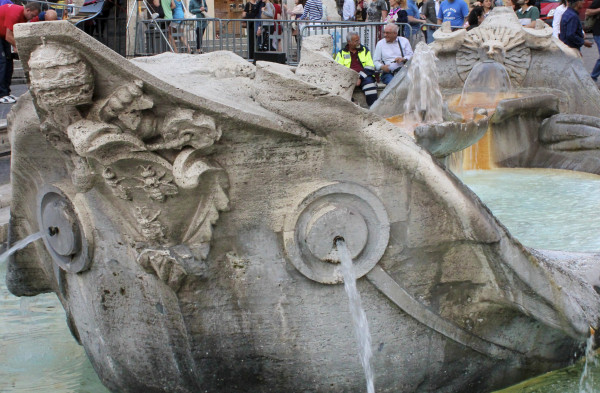 The Bee motif around the Barcaccia fountain is the crest of the Barberini. When the family first came to Rome in the 16th century they had the name Tafani, Italian for horsefly. The symbol used to be horseflies instead of bees. If you wander around Rome you’ll see a lot of bee markings. Pope Urban VIII was busy as a bee building his legacy.
The Bee motif around the Barcaccia fountain is the crest of the Barberini. When the family first came to Rome in the 16th century they had the name Tafani, Italian for horsefly. The symbol used to be horseflies instead of bees. If you wander around Rome you’ll see a lot of bee markings. Pope Urban VIII was busy as a bee building his legacy.
On last note on the Barcaccia fountain. In February 2015, drunken football fans of the Dutch Feyenoord football club of Rotterdam trashed the Piazza di Spagna in what they considered to be an act of team pride. Feyenoord had come to Rome for a match against A.S.Roma, the hometown favorites. According to the owner of a bakery near the Piazza di Spagna, 1,000 football fans who had been drinking since 2:00pm descended on the square, forcing the shop owners to close down for fear their windows and establishments would be smashed.
When the police arrived, hundreds of Feyenoord fans threw bottle and smoke bombs at them. The police replied with tear gas and clubs.
By the time it was, 29 Feyenoord fans were arrested, 13 Police were wounded and the Piazza was strewn with broken bottle and debris.
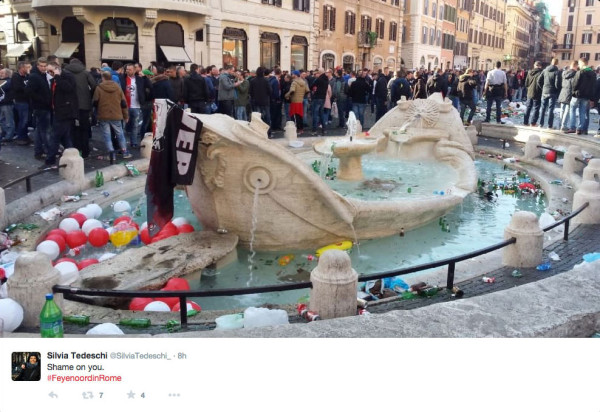 The Barcaccia was filled with beer bottles and trash, damaging the 390 year old travertine stone of Bernini’s fountain. The worst part of the tale is that the fountain had just been restored the previous year to a cost of €209,960 euros.
The Barcaccia was filled with beer bottles and trash, damaging the 390 year old travertine stone of Bernini’s fountain. The worst part of the tale is that the fountain had just been restored the previous year to a cost of €209,960 euros.
A Dutch restoration firm, Royal Woudenberg, offered to spend os to restore the fountain. Royal Woudenberg has the credentials. One of their projects was renovating the Rijksmuseum in Amsterdam. However, according to Rome’s antiquities ministry, the damages to the fountain alone estimated between €750,000 and €1 million euros. They also tacked on million for the loss of value of the fountain, if one could put a value on such a priceless piece. The city of Rome then added €3 million in loss of business, €58,000 in cleanup costs and another €100,000 in damages to buses. They also claimed the damage to the city’s image was between €3-€4 million. I don’t think they expected the Dutch fans to pay this almost €8 million euro cost in damages but they did want to make a point, which they did.
The Dutch felt pretty bad about the violence and so far, donations of around os have been given to the Scusa Roma (Sorry Rome) campaign. It’s a start.
By the way, Feyenoord and Roma tied the match to a 1-1 draw.
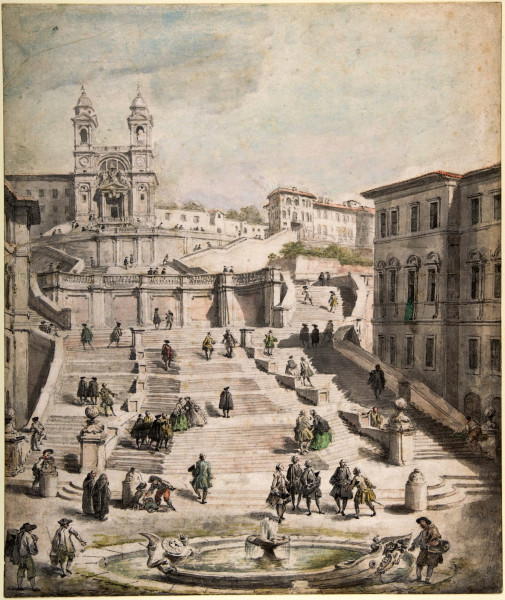
The Spanish Steps – La Scalinata di Spagna
The great staircase, originally named La Scalinata di Trinità dei Monti, was supposed to be a symbol of peace between France and Spain, a bridge between the two communities, the French Trinità dei Monti at the top of the hill and the Spanish Embassy at the bottom, a unification of the Piazza di Spagna and the Piazza di Francia.
The idea for the steps went back to 1559. Pope Gregory XIII wanted to build the staircase to commemorate the 1559 Peace of Cateau-Cambrésis, ending a 65 year Italian Wars between France and Spain.
Of course the peace didn’t last very long. The Franco-Spanish War started in 1635 and went on till 1659. At the end of this conflict, France annexed the French Basque Region.
Étienne Gueffier (known as Stefano Gueffier to the Italians) was the French Diplomat to Rome from 1623-1660, most of it during the Franco-Spanish War.
When he died in 1660, he donated 20,000 scudi (os in today’s currency) to the Minimite Friars who’s monastery was connected to the Trinità dei Monti church. The Minimites used the money to build the Scalinata della Trinità dei Monti. Linking France and Spain was no longer an important issue. The Minimite Friars desire was to link the French church to the Via dei Condotti and across the Tiber River to the Vatican.
It was a French project controlled the Vatican but unfortunately, Pope Alexander VII (Chigi) and French King Louis XIV could never agree on the design. One of the main obstacles was that the outlandish French Sun King demanded a large golden statue of himself in the middle of the stairway.
The project was destined to go to Gianlorenzo Bernini but disputes between Louis XIV and the Vatican held the project up long enough for Bernini to move onto something else.
When Louis XIV died in 1715, the argument of the Sun King statue came to an end, but then, 2 years later, King Philip V of Spain made move to take the French throne.

The War of the Quadruple Alliance, as it was known, ended in 1720 with the defeat of Spain. The Trinità steps were back on.
Several designs were submitted. You can see the difference here between the Specchi and the de Sanctis versions.
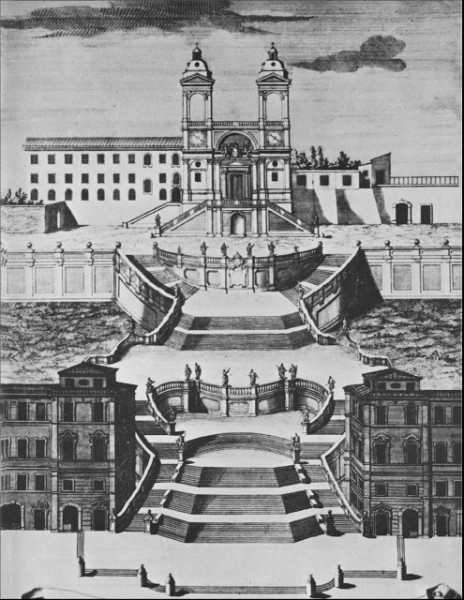
The award for the design finally went to a relatively unknown 38yr old Roman architect named Francesco de Sanctis .
The project finally broke ground in 1723. It was completed 3 years later in 1726, a beautiful waterfall of 138 travertine steps, multi levels of 12 steps each leading to a grand balcony overlooking the Via dei Condotti and outward to the Vatican.
Two years later, in 1728, a retaining wall built to support the steps at the Pincian Hill collapsed due to torrential rains and construction defects. Although the blame was mostly put on the masons working the project, the ultimate scar was put on Francesco de Sanctis. He was sued for neglect and had to make the reparations. The negative press killed his career. Three years later it killed him at age 52.
By the end of the 18th century, life on the Platea Trinitatis was altered forever. References to the Piazza della Trinità dei Monti or Piazza di Francia had disappeared. It was now known as the Piazza di Spagna.
It’s unclear what caused the eventual name change. There was anti’French sentiment in Rome since the 1527 sack of Rome. The French Revolution was not looked at too kindly by the Vatican and Napoleon’s occupation of Rome was hardly well received.
Once the name of the Piazza was changed, the steps soon followed.
 By the beginning of the 19th century the steps became a gathering spot for colorful gypsies, beggars, artists and artist’s models.
By the beginning of the 19th century the steps became a gathering spot for colorful gypsies, beggars, artists and artist’s models.
Beautiful women who wanted to be painted would dress in fine clothing and wait on the steps to be discovered on the Scalinata di Spagna.
In 1953, the film ‘Roman Holiday’ created what we now know as the Spanish Steps when Gregory Peck introduced Audrey Hepburn to a gelato and a stroll across the famous staircase.
The film sparked a love affair between America and Rome and a love affair between the world and Audrey Hepburn.
The apartment of Joe Bradley (Gregory Peck’s character in the film) is at 51 via Margutta, a short walk from the Piazza di Spagna. Via Margutta has always been known for art galleries and artists.
Although Gregory Peck never really lived on the street, Federico Fellini and Giulietta Massina did. A playful caricature on the Via Margutta commemorates their time here. Via Margutta is one of the prettiest streets near the Piazza di Spagna.
 There is something about a long staircase that inspires people to do stupid things. For a while the silly daredevil feats were limited to bicyclists rider going bumpity bump down the steps. Then it all changed in 1963 when a Roman policeman in a Ferrari chased a thief down the staircase.
There is something about a long staircase that inspires people to do stupid things. For a while the silly daredevil feats were limited to bicyclists rider going bumpity bump down the steps. Then it all changed in 1963 when a Roman policeman in a Ferrari chased a thief down the staircase.
In 1993, a car thief broke into Mercedes and drove it down the steps. After years of chipped and stained travertine stone, the steps were restored in 1995. Then, 8 years later in 2003, once again a driver took a wrong turn ended up going down the steps.
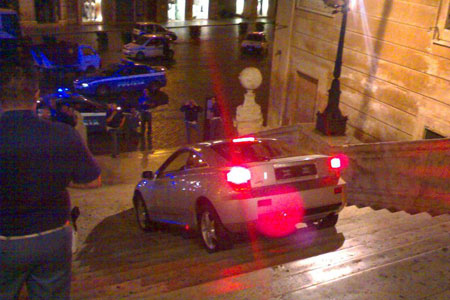
In June of 2007 a 24yr old Colombian man thought the Spanish Steps was a through street going down to the Piazza di Spagna. His Toyota Celica got stuck about halfway down. With the help of some stunned (and very inebriated) patrons from a nearby bar, they tried to push the car back up to the top. It couldn’t be done. Out of resignation, they guided the car to the bottom. That’s where the Polizia arrested him on a DUI and damage to public property.
On January 16, 2008, the Spanish Steps were back in the news when a performance artist released 500,000 colored rubber balls down the steps.
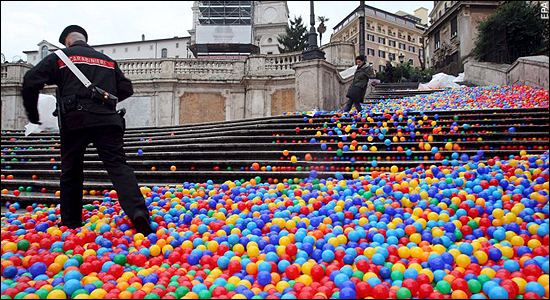 According to the artist, who was arrested soon after the event, each ball represented a lie told by a politician.
According to the artist, who was arrested soon after the event, each ball represented a lie told by a politician.
In October 2015, the Spanish Steps closed to the public for restorations, opening in Spring of 2016. The side ramps will be open for visitors but not the main staircase. 2016 is a Jubilee year in Rome and the Spanish Steps are a big draw.
The €1.5 million euro project is being sponsored by the Fashion House Bulgari in recognition of the 130th anniversary of it’s flagship store on the via Condotti, just off of the Piazza di Spagna.
This is another example of the private sector donating to the patrimony of Italy. Tod’s gave €23 million for the restoration of the Coliseum exterior, Fendi gave €2 million for the Trevi Fountain overhaul, Yagi Tsusho, parent company of Moncler, gave €2 million for the Restoration of the 1st century Pyramid of Cestius.
Hopefully this restoration will include barriers to keep cars off the steps.
Above the Spanish Steps

The twin bell towers of the Church of Trinità dei Monti’s were designed by Giacomo Della Porta, one of the master architects of the late 16th century. The list of Della Porta’s achievements are one of the most impressive in Rome’s history; the Church of the Gusù near Largo Argentina, The Church of San Luigi dei Francesi near the Pantheon, the Church of Sant’Andrea Della Valle near the Campo dei Fiore, the Church of Madonna dei Monti in the heart of the Rioni Monti, Palazzo Chigi, the home of the Italian Prime Minister near the Piazza Colonna and the Great Dome of St. Peter’s Cathedral. This is just a sample of his hand.
He also created many of the beautiful fountains in Rome including the Fontana del Moro (Moor fountain) and the Fontana del Nettuno (Neptune fountain) in Piazza Navona, and the Fontana delle Tartarughe (Turtle fountain) in the Jewish Ghetto, although Bernini added the turtles a hundred years after the fountain was completed.
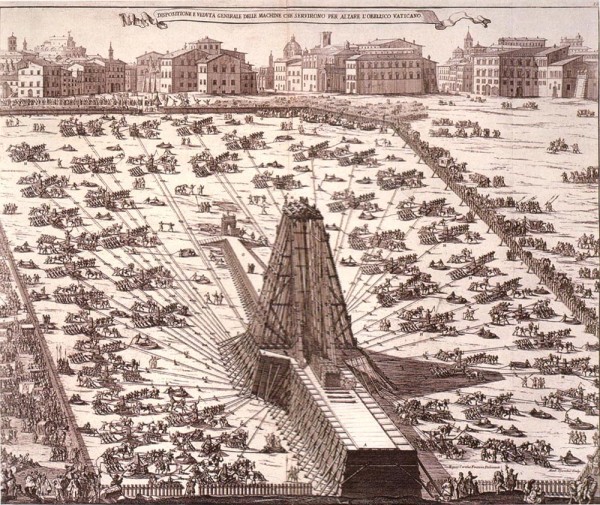
The double staircase in the front of Trinità dei Monti was made by Domenico Fontana, a man most famous for moving and erecting the massive obelisks in Saint Peter’s Square, Piazza del Popolo, Piazza Santa Maria Maggiore and Piazza di San Giovanni in Laterano all within a period of 3 years between 1586-89. The stories of erecting these great monuments are some of the best in Roman History. The 18th century drawing by Niccola Zabaglia detailing how many people it took to erect the obelisk in St Peter’s Square.
Domenico Fontana, however, did not move and erect the obelisk in front of Trinità dei Monti. He had been dead for 82 years. The Sallust Obelisk (as it is known) was erected in 1789.
The Sallust obelisk was moved from the large garden once owned by the Historian, Sallust. Before Sallust it belonged to Julius Caesar. It’s a 1st century Roman copy of the 10BC obelisk to Pharaoh Ramses II currently erected in the Piazza del Popolo. The Sallust was intended to be the second obelisk erected in the Piazza di San Giovanni in Laterano (Saint John in Lateran) but after Domenico Fontana erected the 45.7meter tall, 455 ton Egyptian obelisk there in 1588, had enough and moved onto the Flaminio Obelisk in Piazza del Popolo. Domenico Fontana left Rome soon after when he was accused of misappropriations of public funds by the newly ordained Pope Clement VIII. The Sallust remained horizontal near the Piazza for 55 years until it was reappropriated to the Trinità dei Monti.
This time the Pope didn’t have to argue with the King of France over design decisions. 1789 was the year of the French Revolution.
Inside of Trinità dei Monti works by 16th and 17th century masters including Danielle da Volterra, who was nicknamed Il Braggetone (the underwear maker) because he had the dubious employment to paint underwear on all the nudes of Michelangelo’s ceiling in the Sistine Chapel. They were removed when the chapel was restored.
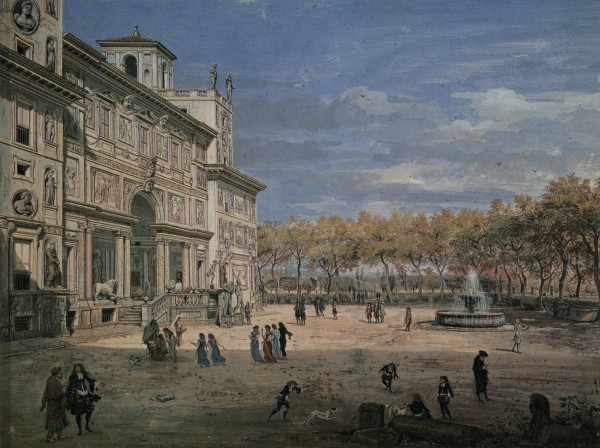
About 225 meters to the left of the Trinità dei Monti is the Villa Medici, a magnificent country villa built in 1574 for the Cardinal Ricci da Montelpuciano. A home inside the city limits is a Palazzo. Outside the city, it’s known as a Villa.
In 1576, the Villa was purchased by Ferdinando I de Medici, the Grande Duke of Tuscany, a man who became a Cardinal of the Vatican at age 14.
Pope Leo XI (Allessandro de Medici) lived here during the early 17th century. Diego Velasquez lived during his visit to Rome in the mid 17th century. His painting of the Villa Medici Gardens here now hang in the Prado Museum.
Galileo Galilei was confined here during his trial in 1630-33.
When Napoleon purchased the building during his occupation in 1803, he created the French Academy for artists. It has remained the French Academy to this day filled with art, art history, stage design, art restoration, photography and cinema arts.
After Queen Christina of Sweden abdicated both her throne and her Lutheran beliefs in 1654, she embraced Catholicism and came to Rome. It was a big coup for the Catholic church and Pope Alexander VII’s welcome was unprecedented.
In 1655, Piazza del Popolo’s Porta Flaminia was redesigned and decorated for her grand arrival. She came through the gate dressed as an Amazon.

In the following days there were parades, parties and free rent for all.
This painting by Filipo Lauri and Filipo Gagliardi shows one of the parties held in her honor at the Palazzo Barberini on February 28, 1656. It was called the Giostra dei Caroselli, the culmination of the 1656 Carnival season. The balconies surrounding the courtyard were built for the occasion.
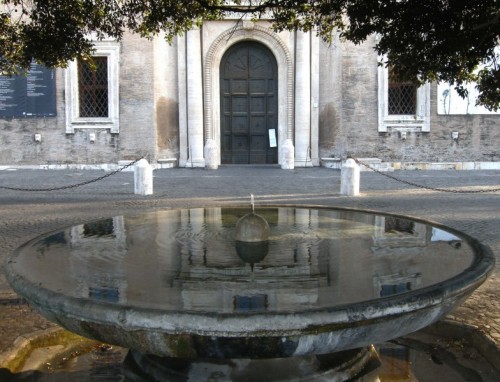 In front of the Villa Medici is a round sphere in a fountain. There is also a round dent in one of the 16th century bronze front doors, original from the 16th century.
In front of the Villa Medici is a round sphere in a fountain. There is also a round dent in one of the 16th century bronze front doors, original from the 16th century.
There are two stories about the dent and the sphere. In one version, Christina arrived to the Villa Medici to meet her lover, the Cardinal Decio Azzolini. When Azzolini didn’t show, Christina went to the Castel Sant’Angelo and fired one of the loaded canons at the Villa. The cannonball dented the bronze door and fell in front of the Villa.
The other story is that when Pope Alexander VII was giving Christina a grand tour of the Vatican and the Castel, she inquired if she might set off one of the cannons. The Pope obliged.
Of course, these are legends. Rome is built on legends. Every cab driver, tour guide and Botticelli horse buggy driver loves to tell the story.
However, it’s 1.8 miles (as the cannonball flies) from the Castel Sant’Angelo to the Villa Medici. This would be no problem for a 19th century cannon, but a 17th century cannon? Maybe not.
130 meters to the right of the Church of Trinità dei Monti is The Palazzetto Zuccari.
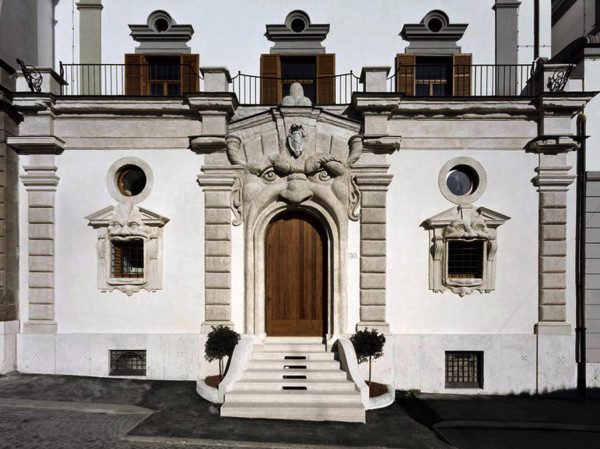 This small Palazzo at the corner of Via Sistina and Via Gregoriana was originally built by Federico Zuccari as an Academy of Art for poor foreign art students.
This small Palazzo at the corner of Via Sistina and Via Gregoriana was originally built by Federico Zuccari as an Academy of Art for poor foreign art students.
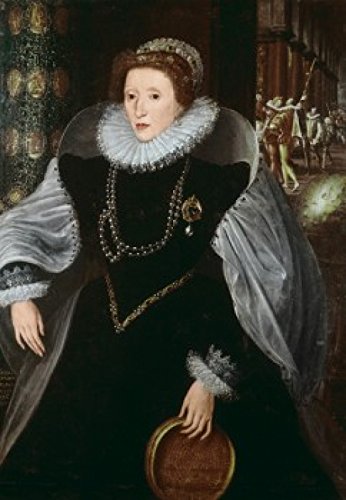
Zuccari, the younger brother of Renaissance painter, Taddeo Zuccari. was a major influence in the 16th century school of Mannerist painters, a pre Baroque period that combined classical influence with realism. He is most noted for his portrait of Queen Elizabeth I of England and her lover Robert Dudley.
Zuccari was also a great fresco artist who’s work can be seen in the Duomo of Florence, The church of Trinità dei Monti and inside his Palazzetto Zuccari.
The Palazzetto Zuccari is one of the secret pleasures of Rome. It’s not on the major tourist maps but it well worth the visit. It’s a 16th century monster house. The front doorway is a walk through the mouth of an evil Djinn. The two windows to the left and right of the doorway repeat the demonic décor, although the faces on the windows seem to be a little more cheerful.
The house was built in the late 16th century. In the early 17th century, it was occupied by Queen Marie Casimire Louise of Poland. She ordered the balcony to be built above the monstrous doorway in 1711.
The father of Art History, Johann Joachim Winckelmann lived here from 1755-1768. In 1768, he left the Palazzo for a trip to the Alps. He returned through Vienna where he was given a few imperial medals by the Empress Maria Theresa. On his way back to Rome he stopped in Trieste. After showing the medals to another traveler at his hotel, he was killed and robbed. The killer, Francesco Arcangeli was executed a month later.
Winckelmann had a profound effect on art historians for many years although many of his observations have since proven to be wrong.
Jacques Louis David, the neoclassical painter of the French Revolution and favorite portrait artist of Napoleon, painted one of his masterpieces, ‘The Oath of the Horati” in the Zuccari Palace in 1784. The painting is on display in the Louvre.
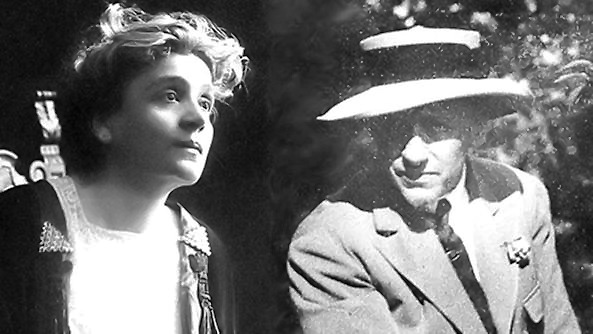
In the 20th century is was a favorite destination for the Italian writer and World War I hero, Gabriele D’Annunzio and the great 20th century Italian actress, Eleonora Duse.
In 1904, the Palazzo was sold the house to Henrichetta Hertz, a German art collector living in Rome. She donated most of her collection to the Italian State in 1913. The Palazzo Zuccari is now the German Herziana Art Library.
Hours are Mon-Fri 9:30am-8pm but you must first get a user ID card. ID cards are issued on Monday and Tuesday 9:30am-11am and on Wednesday 3p-5p. This is a great opportunity to see the magnificent frescos inside the home.
Piazza di Spagna and the Age of Romanticism
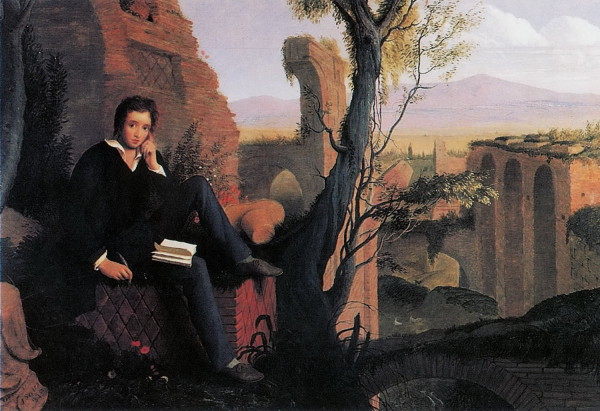
The Grand Tour of the 17th century brought a new interest in classical art, albeit mostly for wealthy Europeans. Upper-class Brits and gentry from northern Europe found a renewed interest in history, art and architecture of the Netherlands, Belgium, Germany, France, Switzerland and Italy.
The Grand Tour in Great Britain was halted during the time of Napoleon, mostly because Great Britain was literally cut off from the Continent. But after Napoleon’s defeat in 1815, English nobility came to Europe with a newfound passion that became known as the Age of Romanticism.
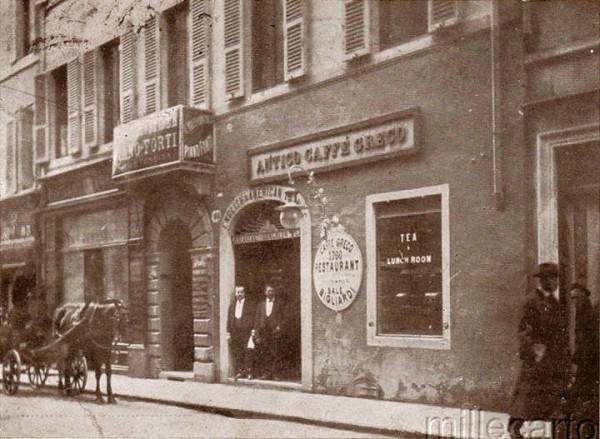 In the 19th century, the community on the Piazza di Spagna had grown considerably.
In the 19th century, the community on the Piazza di Spagna had grown considerably.
The Café Greco on the via Condotti, which opened its doors in 1760, became a favorite haunt for Goethe, Stendhal, Baudelaire, Wagner, Gogol, Liszt, Keats, Shelley, Ibsen, Mendelssohn, Hans Christian Andersen, Buffalo Bill Cody and lots more. Even Casanova was rumored to enjoy the locale.
The most influential of the Romantics in Rome were Lord Byron, Percy Bysshe Shelley and John Keats.
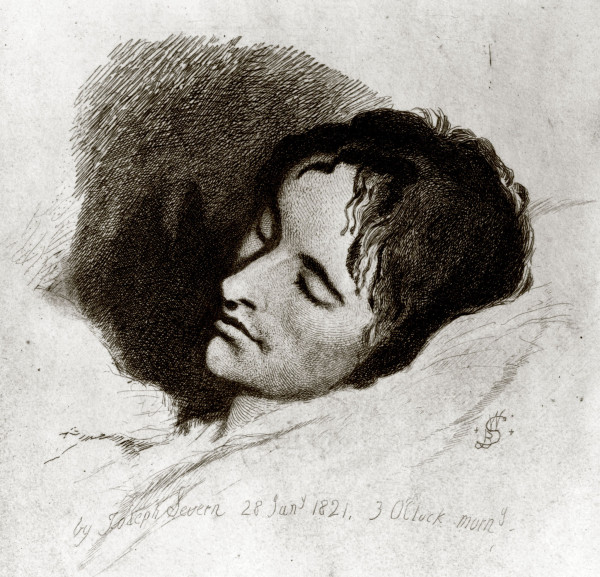
In 1820, Keats and his friend, Joseph Severn, lived in a small guest house in the Piazza di Spagna next to the Spanish Step. Keats died in the house on February 23, 1821.
He is interred in the Protestant Cemetery of Rome near the Pyramid of Cestius. Severn became the British Consul from 1860-1872.
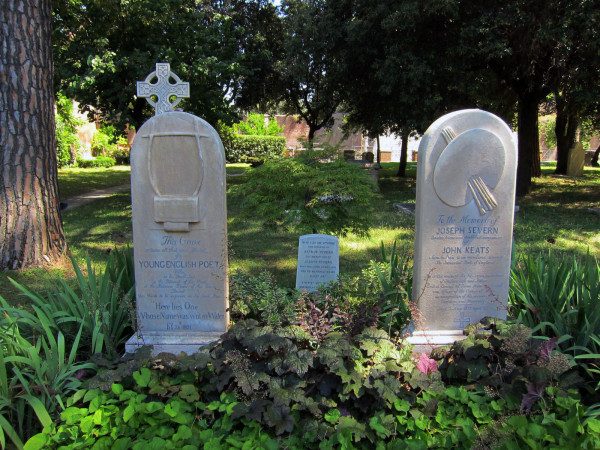
When he died, he was interred next to his old friend. The death mask of John Keats is still in the room of the guest house where he died.
The house was purchased in 1906 by the Keats-Shelley Memorial Association. It has been open as a museum (books, letters and manuscripts) since 1909.
Elizabeth Barrett Browning lived on the corner of via Bocca di Leone and via del Lupo in the winter of 1860-1861 just before she went to Florence where she died a few months later. She is interred in the English Cemetery of Florence.
In 1893, Anna Maria Babington and her partner Isabel Cargill opened up the Babington’s Tea Rooms next to the Spanish Steps.
Anna Maria Babington was a descendant of Anthony Babington who was hanged, drawn and quartered for leading a conspiracy against Queen Elizabeth I. Isabel Cargill was the descendant of a man executed by King Charles II for denouncing the tyranny of the King. Her father founded the city of Dunedin in New Zealand.
Anna Maria Babington retired in 1928 but the shop has been going strong for years. It has been the only place in Rome for a cup of English tea.
Piazza di Spagna kept it’s artist feel through the 1960s.
Guglielmo Marconi, the inventor of the radio, lived at Via dei Condotti 11 until his death in 1937.
Giorgio de Chirico, the 20th century metaphysical painter, lived a couple doors down from the Keats-Shelley House from 1947 till his death in 1978. After his death, his wife, Isabella, dedicated three floors of the house as a museum to his memory. They are filled with paintings and memorabilia. It’s also a great peak into a Roman residence of the 1950/60s.
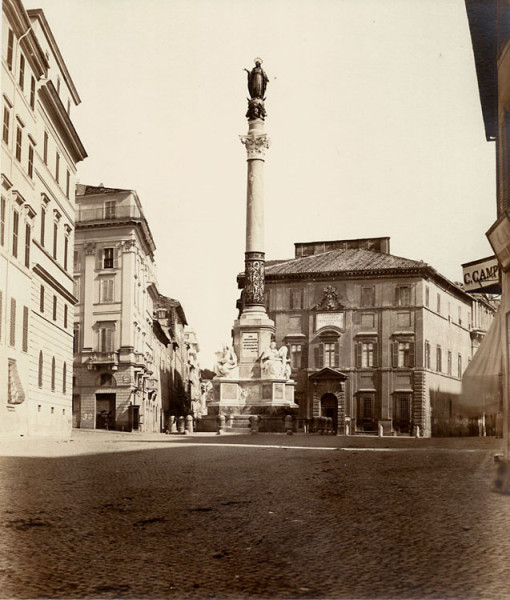
On December 8th 1857, a 29meter tall ancient Roman column was erected in the Piazza Mignanelli, across the way from the Spanish Embassy and in front of the Palazzo di Propaganda Fide (the center of the Holy See’s marketing Department).
It is one of the very few buildings in Rome that was designed and built by both Gianlorenzo Bernini and Francesco Borromini. The rivalry of these two great artists is legendary.
They very rarely even spoke to each other and most likely worked on the Palazzo di Propaganda Fide at different times.
The ancient column is crowned with a statue of the Mother Mary, a commemoration of the dogma declared by Pope Pius IX in 1854 declaring the Immaculate Conception of the Virgin Mary in the womb of her mother, the Saint Anne.
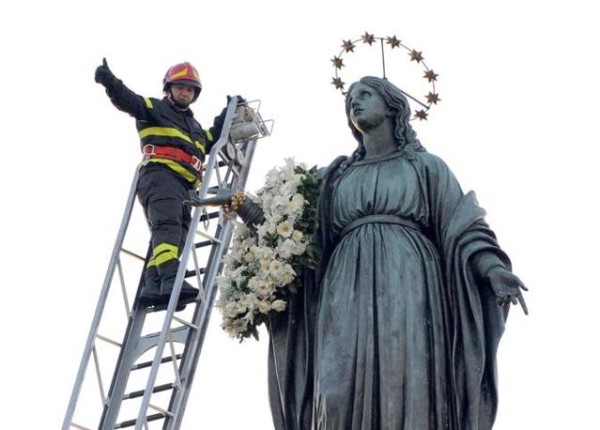
As Holy as the column might be in intention, over the years it’s also been revered by Romans for the sexual innuendo of the horns and forked beard of the statue of Moses at the base of the column.
The Immaculate Conception Column was erected by city firemen and consequently, every year on December 8th, for the Festival of the Immaculate Conception, the firemen of Rome scale a ladder and place a wreath on the arm of the Virgin Mary.
The Fashionistas of the Piazza di Spagna
 When Bulgari opened it’s shop of curios on Via dei Condotti in 1905, they altered the neighborhood forever. Gucci followed in 1938. Battistoni, the favorite tailor of the Duke of Windsor, Marlon Brando and Humphrey Bogart, opened it’s doors on the Via dei Condotti in 1946. The Via dei Condotti was soon filled with the best fashions of Europe. By the 1960s the shops spread to Via Borgognona, Via Frattina, Via delle Carrozze, Via Mario de’Fiori and Via del Babuino.
When Bulgari opened it’s shop of curios on Via dei Condotti in 1905, they altered the neighborhood forever. Gucci followed in 1938. Battistoni, the favorite tailor of the Duke of Windsor, Marlon Brando and Humphrey Bogart, opened it’s doors on the Via dei Condotti in 1946. The Via dei Condotti was soon filled with the best fashions of Europe. By the 1960s the shops spread to Via Borgognona, Via Frattina, Via delle Carrozze, Via Mario de’Fiori and Via del Babuino.
The streets are filled with Roman designers; Valentino, Fendi, Brioni, Laura Biagiotti, Sorelle Fontana, Capucci, Fernanda Gattinoni, Lancetti and Gai Mattiolo. There are Italian designers; Armani, Ferragamo, Dolce e Gabbana, Prada, Furla, Max Mara, La Perla, Missoni, Moschino, Ermanno Scervino, Trussardi, Tod’s, Versace, Byblos, Roberto Cavalli, Ermenegildo Zegna, Emilio Pucci, Gucci, Brunello Cucinelli. French designers include Hermés, Cartier, Chanel, Louis Vuitton, Ungaro, Yves Saint Laurent. There are British designers, Japanese and American, German and Australian. You can also go closer to the Via del Corso for more moderately priced fashions. There are so many more to choose from.
Spain has some very popular fashion houses; Adolfo Dominguez, Mariano Fortuny, Balenciaga and Manolo Blahnik to name a few, but their presence in the Piazza di Spagna is minimal.
Yes, there isn’t much of anything Spanish near the Spanish Steps.
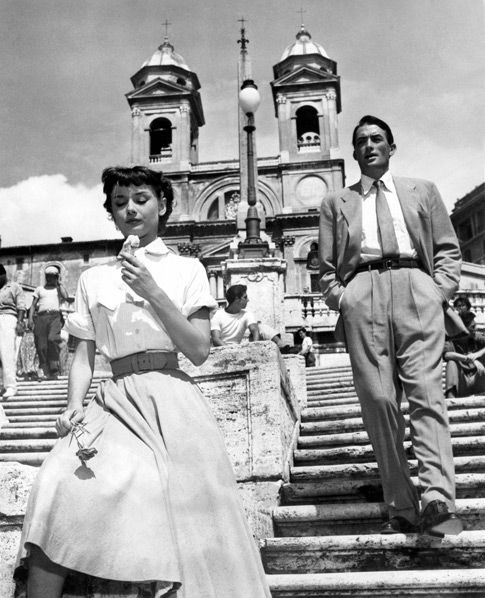
You must be logged in to post a comment.